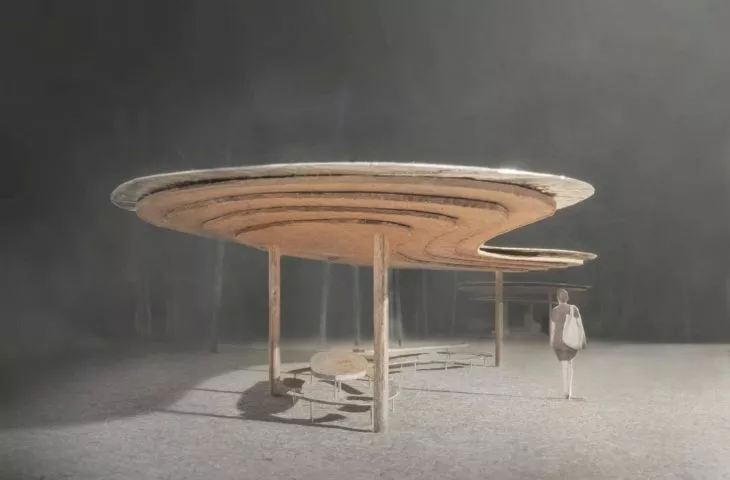The Vistula riverfront in Warsaw's Wawer district has a chance to soon become an attractive place for residents who like to spend their free time surrounded by nature. Architects from the Karol Żurawski atelier design studio have prepared a project for the development of riverside recreational areas in the vicinity of Rychnowska Street and the blue fin-like Kępa Wieloryb. The project is planned to be completed by May 2021.
scope of the study
© Karol Zurawski, design atelier
The proximity of water, distant views of open space, natural riparian forests and willow thickets providing a sanctuary for wild birds, are the most significant of the many qualities of the area periodically inundated by river surges. We are working with the terrain, water, vegetation and small architecture at the site, with the aim of making these valuable natural areas more accessible. The project envisages creating places friendly to people seeking rest and contact with nature without interfering with the natural character of the space, the project authors write.
Glade on the Vistula River at Rychnowska Street
© Karol Żurawski, design atelier
In the first stage, the existing clearing located directly on the river near Rychnowska Street will be cleaned up. There, a new recreational clearing with a naturalistic playground and wooden canopies with picnic tables will be created on a higher floodplain terrace. In their design, the architects do not dominate the existing space. Through small architecture with gentle, curved shapes, they organize it, supplementing it with useful wooden elements for residents.
Kępa Kępa Whale beach
© Karol Żurawski, design atelier
In the next stage of implementation, the area on Rychnowska Street will be connected by a path to the city's sections of the recreational route running through the riparian forest on the right bank of the Vistula, a footbridge will be built over the Old Vistula River bed, and a new, extensive beach will be created on Kępa Wieloryb.
Ola Kloc: What was the principal's priority?
Karol Żurawski: About ten years ago in Warsaw, on the Praga side of the Vistula, directly on the water, in a wildly overgrown area of riparian forest, a beautiful scenic recreational path was laid out, winding between trees. I remember that the first time I went there I was deeply moved. In the center of a large European city, one can experience a magnificent, lush nature and a view of a wide river with a forest of skyscrapers in the background. This was the realization of the idea of Mark Piwowarski, who later became director of the Greenery Board. A man, in my opinion an outstanding one, thanks to whom Warsaw has gained a great deal in terms of greenery and access to the river landscape. It was during his time at the helm that the Board of Greenery commissioned us to design recreational areas along the Vistula River in Wawer. The project, which we worked on with landscape architect Lukasz Kowalski, is part of a larger whole: the idea of making naturally and scenically beautiful areas along the river available to Warsaw residents, but in such a way as to preserve the natural character of the place. In the future, the path in the riparian forest will be able to walk along the Vistula River along the entire length of the city, all the way to the areas we are designing in Wawer.
Clay model of stepped terraces over the river
© Karol Zurawski, design atelier
Ola: What was the biggest challenge in the project, and what are you most satisfied with?
Karol: The river is an unpredictable element. It can flow at a speed of two meters per second and has tremendous power. Its level is constantly fluctuating, and once in a while it occurs from the riverbed and floods adjacent areas. The flood, which happens on average once every hundred years, inundates our project area in its entirety. We had to take this into account when designing, and this was the biggest challenge.
In the floodplain, the greenery has a unique and beautiful character. There are plant species that tolerate the rising water level well. We planned a large amount of new greenery so as to create spaces where it would be pleasant to spend time. We selected species that correspond to those found naturally in the area. Our ambition was that in a few decades, when the planted plants have grown, these areas will look not like man-designed, but created by nature. When this succeeds, we will be very pleased.
model of a wooden canopy
© Karol Zurawski, design atelier
Ola: What influenced the organic shapes of the small architecture?
Karol: The form of small architecture can, of course, be associated with the organic shapes of the natural Vistula River landscape: the undulating shoreline or the numerous riverside lakes in the area. But the truth is that this somewhat poetic form is due to very pragmatic reasons. The streamlined shape reduces water resistance significantly, so the pressure force in the event of a flood will be significantly lower. In addition, the roof has a cantilevered structure and its rounded outline makes the most sense from the point of view of construction logic and material consumption. One could talk about the pavilions for a long time. Their construction is all wood and innovative. For the project we worked with two great designers: Wojciech Kapela and Dr. Neven Kostic, who has a studio in Zurich.




























